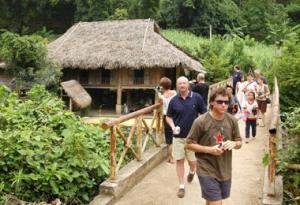Are you ready for the country?

After a two hour drive from ${bigcity_Hanoi:"Hanoi"} you will arrive at Giang Mo village in Cao Phong district of Hoa Binh province, where Muong people live in a wonderfully idyllic setting.
It remains relatively tourist free to promote itself as a ‘tourism village.’ The village is populated by Muong people, the third largest ethnic group in Vietnam with an estimated population of 1.2 million, the bulk of which dwell in the mountainous regions of Hoa Binh or Thanh Hoa provinces.
A hundred stilt-houses built on the mountain slope look down onto the terraced fields of the villagers. Outside each house, there is a small shrine dedicated to the Muong people’s gods and ancestors. The bucolic landscape is inspiring. The autumnal air is fresh and fragrant. You can smell young sticky-rice and wild flowers in the air.
The locals born and bred in this bewitching, near hypnotic spot, are friendly and full of smiles – even as they work. Women weave fabric and embroider brocades or shell corn. The men busy themselves by sharpening knives or making bows and arrows.
By and large, the traditional lifestyle is untainted here. Bamboo water wheels and half-pipes irrigate the fields. Houses use wooden rice mortars and handmade reaping-hooks. Furniture is made out of rattan. The village lives off of farming rice and breeding poultry and/or cattle, not tourism.
Tourists are shown around the village. At one of the biggest stilt-houses they are offered tea made from a peach tree’s roots. While his wife is busy preparing lunch, Ha Van Can, the owner of the house, talks about the Muong people’s ancient customs, lifestyle and habits. He is clearly house-proud.
The stilt-house is quite long and high. It is made with large wooden pillars, bamboo walls and floorboards, and a thatched roof of palm leaves. There is no private room in the house. The cooking fire is placed in the middle of house. Here, a pot is always on the boil. Dried corn hangs from the smoking-shelf above the fire.
Can displays his hunting trophies – a large wild ox skull complete with horns, a fanged wild boar, and the teeth of a bear he says he hunted for over 40 years! “Now there are very few wild animals here,” he says, perhaps not sensing the bitter irony that he played a part in their demise. He attributes the loss of wild animals to the forests being destroyed. “The government banned the hunting of wild animals, so I make hunting knives, bows and arrows for tourists, mainly,” says Can.
“Most of the households in our village still preserve the typical culture and lifestyle of ancient Muong people because the authorities want to turn our village into a tourist spot,” he says. “We want to earn more money from tourism, but you can see that not many tourists visit our village. If you stay overnight, you can enjoy traditional dances, folksongs and performances with drums, gongs, clarinets and the monochord. Our village has a special team of girls and boys performing traditional music for guests.”
Can’s wife says, “For generations, Muong women have had to learn to weave and dye cloth, make brocades and sew clothes for their families. Muong women are very good at cooking also.”
“Our daily diet is very simple, but for festivals our feasts are more sophisticated.” The proof is in the pudding. In front of me there’s a feast with sticky rice wrapped in banana leaves, boiled wild vegetables, river fish cooked with wild herbs and wrapped in lotus leaves, steamed chicken and stir-fried buffalo.
It’s worth driving to Giang Mo for the food alone! Giang Mo village is in Binh Thanh commune, Cao Phong district, Hoa Binh province, 90km west of Hanoi. To get there from Hanoi, you can drive through Ha Dong city on National Road 6 towards Hoa Binh city. Keep going straight, don’t turn left toward Mai Chau, and after 10km Giang Mo will be on your left hand side – you can’t miss it!









